LIGHTHOUSES, SEABIRDS, WHALES AND MONOLITHS
“Quebec's Mingan Archipelago National Park Reserve is both distinctive and spectacular!”
By Jamie Ross
Getting stranded on a small, windswept, bird-infested island surrounded by Minke whales, dolphins and seals on the St. Lawrence River's north shore, might appear at first glance to be the setting for some horror film plot - especially when my living quarters was in an historic working lighthouse station. In reality, staying on the Ile aux Perroquets in Quebec Maritime's distinctive and spectacular Mingan Archipelago National Park Reserve was more a romance - I fell in love with the place! The island and its dramatic setting exceeded my expectations. Besides, the boat that dropped me off did, as promised, come back the next day to pick me up. Not that I was ready to leave.
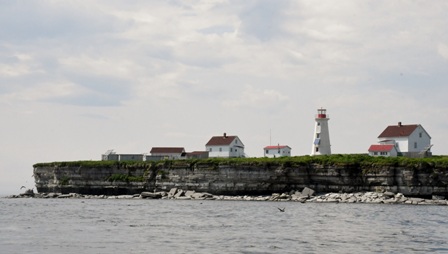
You can book an overnight stay at the lighthouse station on the Ile aux Perroquets
Along the North Shore of the Gulf of St. Lawrence is a remarkably beautiful scattering of nearly a thousand islands, granitic islets and reefs sprinkled along a narrow swath 150 kilometres east to west. Founded by Parks Canada in 1984, this relatively small and little known park receives roughly 35,000 guests each year, and although the reserve is restricted to the islands themselves, it becomes quite obvious when visiting that it is the sea that shapes everything; sea life, birdlife, wildlife, plant life, rock formations, the climate, and even the visitor's experience itself.
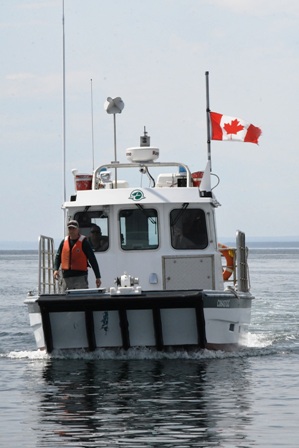
The park reserve is open from June until early September and is only accessible by boat. This Parks Canada vessel is uniquely built with an angled front for docking on beaches.
Two days earlier, dressed in warm survival floatation suits, we pulled away from the small marina at Havre-Saint-Pierre on a Parks Canada vessel, uniquely built with an angled front for docking on beaches. The Mingan Archipelago is best known for its eerie assemblage of limestone monoliths, the largest collection of its kind in Canada. Along the shores of Mingan's larger islands, they appear as sentries, tottering sand castles or gigantic mythical beasts, carved by nature's forces and ranging in height from a few metres to more than 20 metres high.
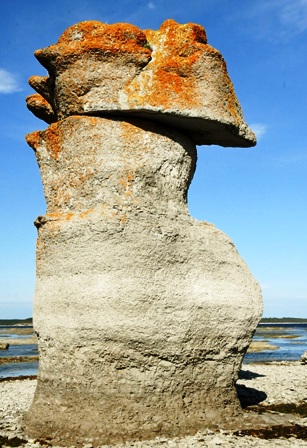
The Mingan Archipelago is best known for its eerie assemblage of limestone monoliths.
Our first island destination is Île Niapiskau. We follow a boardwalk into the island's damp interior forest where we find hidden in the trees, among the berries and mosses, some of these imposing limestone monoliths. The other islands in the chain are equally as intriguing and spectacular; Île du Fantôme, Grosse Île au Marteau, Grande Île, Île Quarry, Île Nue de Mingan and Petite Île au Marteau. It is easy to while away a day or two exploring the wild shorelines, boreal forests and peat moss barrens. I venture onto the rocky flats at low tide, walking on the seemingly endless rocky and sandy beaches, while marvelling at the unique and hardy seashore flora and the diversity of marine organisms that make their home in the tidal pools.
On Petite Île au Marteau there are old lighthouse buildings and a schoolhouse, where you can discover local history and culture. Hiking on the larger central islands takes you through a diversity of ecosystems; coniferous forests, bogs, barrens, small lakes, salt marshes, seashores and cliff habitats. The Île Nue de Mingan is a treeless island with fascinating Arctic and subarctic vegetation. And the magnificent monoliths are everywhere, on most islands – on the tidal flats and in the depth of the forests.
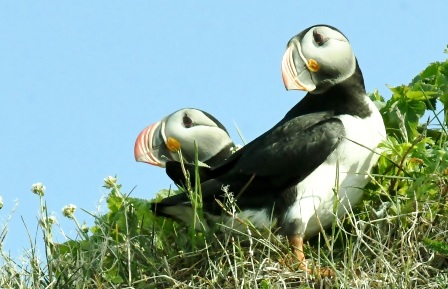
With its clown-like appearance, the puffin or “sea parrot” prefers to nest on the smallest islands of the archipelago. The birds arrive in the islands in April and remain until September.
In addition to the otherworldly landscape, the Mingan Archipelago is home to large colonies of astonishing birds, including the magnificent Atlantic puffin and the Razorbill. During breeding season the park shelters thousands of marine birds, including passerines, birds of prey, Red Knot rufa, cormorants, kittiwakes and guillemots. It is also home to the largest concentrations of terns and common eiders in the Gulf of St. Lawrence. Minke whales, dolphins and seals can often be seen, drawn to these cold waters teeming with plankton and fish.

On Île Quarry you can spend the night in a Parks Canada o'TENTik
One can visit the islands on day trips or afternoon tours, or it is possible to stay overnight at one of the 42 campsites available. My accommodation for one night is a Parks Canada o'TENTik on the Île Quarry. The comfortable tented structure is just off the stone beach. I enjoy a barbecue dinner and afterwards sit out under a starry sky beside an ocean-side bonfire. Then, on the second night of my visit, I enjoyed the unique island experience overnighting at the lighthouse station on the Île aux Perroquets. The lighthouse B&B can be booked and accessed by regular charter boats or by kayak.
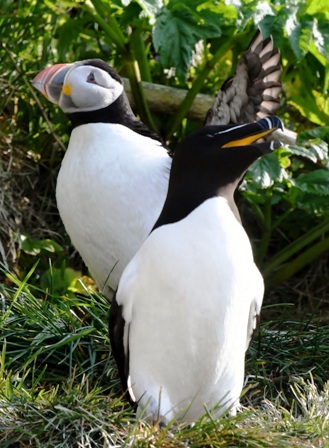
Puffins and razorbills welcome visitors to the Île aux Perroquets.
The island is charming. As my luggage is off-loaded and taken ahead to my room, puffins and razorbills fly by to welcome me. Local treats and cocktails await our group's arrival in a quaint outbuilding called the “Hen House.” Afterwards I explore the foghorn building, taking in the exhibits of the lighthouse's history and the lives of those who cared for it. I climb to the top of the lighthouse for the awesome views, imagining how it would have been to live on this small and lonely island. As a visitor it is a beautiful place of peace and freedom – I fall asleep to the chatter of the sea birds, the sound of wind and the rhythm of the waves crashing against the island's rugged cliffs.
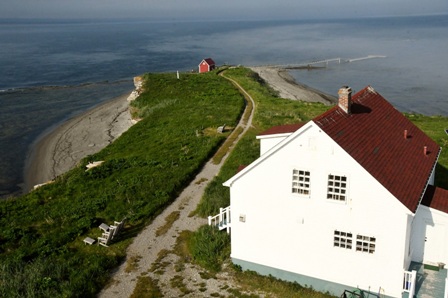
The view of the Île aux Perroquets from the top of the lighthouse tower
IF YOU GO
How to Get There
It is a 10 hour drive along the north shore from Quebec City to the park or you can fly into Sept-Îles and drive two hours east on Hwy 138. The Mingan Archipelago stretches along the north shore of the Gulf of St. Lawrence between the towns of Longue-Pointe-de-Mingan and Aguanish.
Getting around the Mingan Archipelago
The park reserve is open from June until early September and is only accessible by boat. The most popular way to visit the Mingan Archipelago is to take one of the boat tours offered by commercial marine transportation companies departing from Longue-Pointe-de-Mingan and Havre-St.-Pierre. Tours usually last three to five hours and allow a visit to several different islands, and include guided visits led by Parks Canada interpreters. Should you prefer to see the Mingan via kayak check out Noryak Adventures based in Havre-St.-Pierre. www.noryak.ca
Information:
Whether you embark on a short three-hour boat tour, a longer visit with stays on the islands, or a multi-day kayak journey, be sure to begin your visit the Parks Canada visitor information and interpretation centres located in Longue-Pointe-de-Mingan or Havre-St.-Pierre. Obtain all necessary maps, information, and permits. Take a tour of the Mingan Islands Cetacean Studies Centre adjacent to the Parks Canada information center in Longue-Pointe-de-Mingan. It provides a fabulous opportunity for visitors to dive deep into the fascinating underwater world of whales.
Mingan Archipelago National Park: 1-888-773-8888 or www. parkscanada.gc.ca/Mingan.
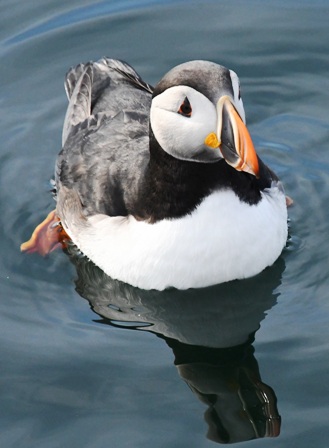
The Atlantic Puffin is a highlight of any visit to the Mingan Archipelago National Park Reserve.
Photos: All images by Jamie Ross